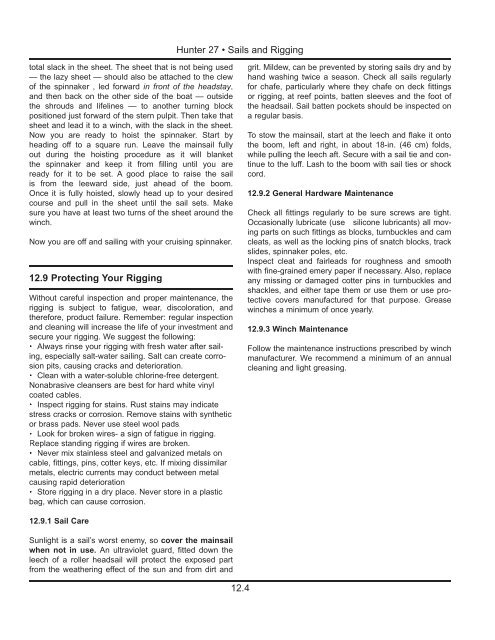27 Operator's Manual.. - Marlow-Hunter, LLC
27 Operator's Manual.. - Marlow-Hunter, LLC
27 Operator's Manual.. - Marlow-Hunter, LLC
Create successful ePaper yourself
Turn your PDF publications into a flip-book with our unique Google optimized e-Paper software.
<strong>Hunter</strong> <strong>27</strong> • Sails and Rigging<br />
total slack in the sheet. The sheet that is not being used<br />
— the lazy sheet — should also be attached to the clew<br />
of the spinnaker , led forward in front of the headstay,<br />
and then back on the other side of the boat — outside<br />
the shrouds and lifelines — to another turning block<br />
positioned just forward of the stern pulpit. Then take that<br />
sheet and lead it to a winch, with the slack in the sheet.<br />
Now you are ready to hoist the spinnaker. Start by<br />
heading off to a square run. Leave the mainsail fully<br />
out during the hoisting procedure as it will blanket<br />
the spinnaker and keep it from filling until you are<br />
ready for it to be set. A good place to raise the sail<br />
is from the leeward side, just ahead of the boom.<br />
Once it is fully hoisted, slowly head up to your desired<br />
course and pull in the sheet until the sail sets. Make<br />
sure you have at least two turns of the sheet around the<br />
winch.<br />
Now you are off and sailing with your cruising spinnaker.<br />
12.9 Protecting Your Rigging<br />
Without careful inspection and proper maintenance, the<br />
rigging is subject to fatigue, wear, discoloration, and<br />
therefore, product failure. Remember: regular inspection<br />
and cleaning will increase the life of your investment and<br />
secure your rigging. We suggest the following:<br />
• Always rinse your rigging with fresh water after sailing,<br />
especially salt-water sailing. Salt can create corrosion<br />
pits, causing cracks and deterioration.<br />
• Clean with a water-soluble chlorine-free detergent.<br />
Nonabrasive cleansers are best for hard white vinyl<br />
coated cables.<br />
• Inspect rigging for stains. Rust stains may indicate<br />
stress cracks or corrosion. Remove stains with synthetic<br />
or brass pads. Never use steel wool pads.<br />
• Look for broken wires- a sign of fatigue in rigging.<br />
Replace standing rigging if wires are broken.<br />
• Never mix stainless steel and galvanized metals on<br />
cable, fittings, pins, cotter keys, etc. If mixing dissimilar<br />
metals, electric currents may conduct between metal<br />
causing rapid deterioration<br />
• Store rigging in a dry place. Never store in a plastic<br />
bag, which can cause corrosion.<br />
grit. Mildew, can be prevented by storing sails dry and by<br />
hand washing twice a season. Check all sails regularly<br />
for chafe, particularly where they chafe on deck fittings<br />
or rigging, at reef points, batten sleeves and the foot of<br />
the headsail. Sail batten pockets should be inspected on<br />
a regular basis.<br />
To stow the mainsail, start at the leech and flake it onto<br />
the boom, left and right, in about 18-in. (46 cm) folds,<br />
while pulling the leech aft. Secure with a sail tie and continue<br />
to the luff. Lash to the boom with sail ties or shock<br />
cord.<br />
12.9.2 General Hardware Maintenance<br />
Check all fittings regularly to be sure screws are tight.<br />
Occasionally lubricate (use silicone lubricants) all moving<br />
parts on such fittings as blocks, turnbuckles and cam<br />
cleats, as well as the locking pins of snatch blocks, track<br />
slides, spinnaker poles, etc.<br />
Inspect cleat and fairleads for roughness and smooth<br />
with fine-grained emery paper if necessary. Also, replace<br />
any missing or damaged cotter pins in turnbuckles and<br />
shackles, and either tape them or use them or use protective<br />
covers manufactured for that purpose. Grease<br />
winches a minimum of once yearly.<br />
12.9.3 Winch Maintenance<br />
Follow the maintenance instructions prescribed by winch<br />
manufacturer. We recommend a minimum of an annual<br />
cleaning and light greasing.<br />
12.9.1 Sail Care<br />
Sunlight is a sail’s worst enemy, so cover the mainsail<br />
when not in use. An ultraviolet guard, fitted down the<br />
leech of a roller headsail will protect the exposed part<br />
from the weathering effect of the sun and from dirt and<br />
12.4

















